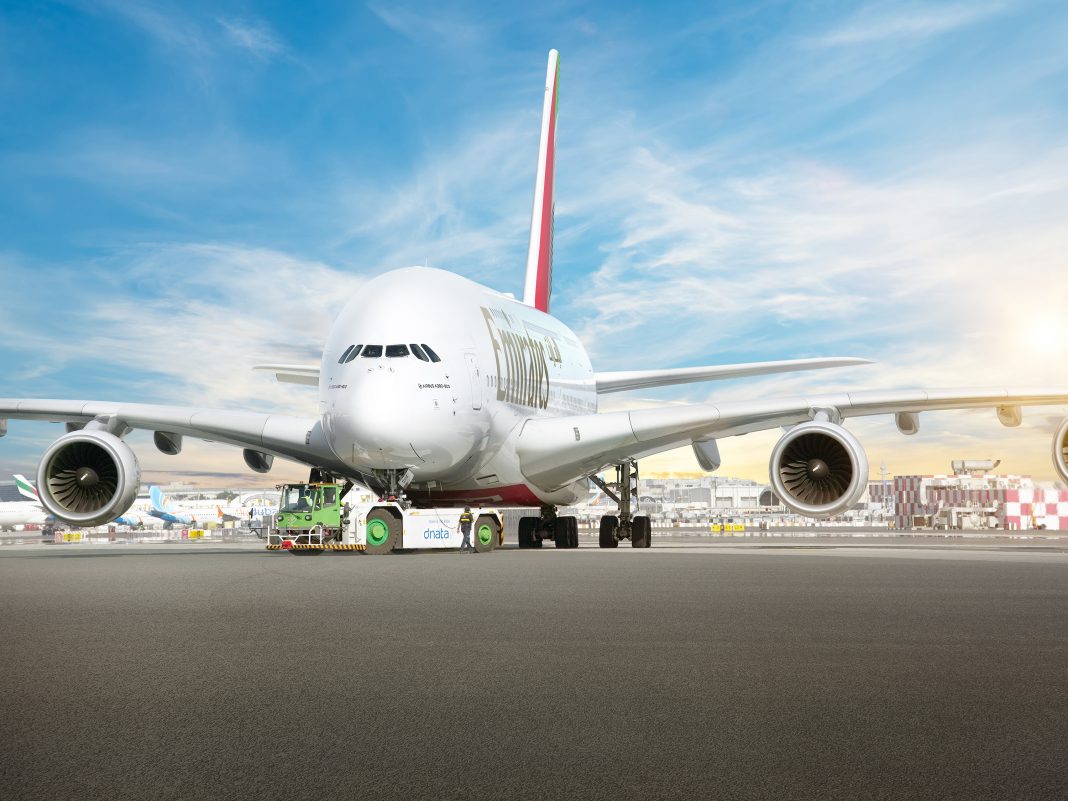The Emirates Group announced its best-ever half-year financial performance, posting a profit before tax of AED10.4 billion ($2.8 billion) for the first six months of 2024-25, surpassing its record profit before tax for the same period last year.
This is the first financial year that the UAE corporate income tax, enacted in 2023, is applied to the Emirates Group. After accounting for the 9 percent tax charge, the group’s profit after tax is AED9.3 billion ($2.5 billion).
Demonstrating its strong operating profitability, the group maintained a robust EBITDA of AED20.4 billion ($5.6 billion), slightly lower from AED20.6 billion ($5.6 billion) last year, the gourp said.
Group revenue was AED70.8 billion ($19.3 billion) for the first six months of 2024-25, up 5 percent from AED67.3 billion ($18.3 billion) last year. This reflects the consistently strong customer demand across business divisions, and across regions.
The group closed the first half year of 2024-25 with a solid cash position of AED43.7 billion ($11.9 billion) on September 30, 2024, compared to AED47.1 billion ($12.8 billion) on March 31, 2024. The group has been able to tap on its own strong cash reserves to support business needs, including payments for new freighter aircraft orders and other debt payments. The group also paid AED2 billion in dividend to its owner, as declared at the end of its 2023-24 financial year.
Sheikh Ahmed bin Saeed Al Maktoum, Chairman and Chief Executive, Emirates Airline and Group, said: “The group has surpassed its record performance of last year to deliver a fantastic result for the first half of 2024-25. This again illustrates the power of our proven business model working in combination with Dubai’s growth trajectory as a city of choice to live, work, visit, connect through, and do business in.
“The group’s strong profitability enables us to make the investments necessary for our continued success. We’re investing billions of dollars to bring new products and services to the market for our customers; to implement advanced technologies and other innovation projects to drive growth; and to look after our employees who work hard every day to ensure our customers’ safety and satisfaction.”
Sheikh Ahmed added: “We expect customer demand to remain strong for the rest of 2024-25, and we look forward to increasing our capacity to grow revenues as new aircraft join the Emirates fleet and new facilities come online at dnata. The outlook is positive, but we don’t intend to rest on our laurels. We will stay agile in deploying our capacity and resources in a dynamic marketplace.”
To support increased operations and business activities, the Emirates Group’s employee base, compared to March 31, 2024, grew 3 percent to an overall count of 114,610 on September 30, 2024. Both Emirates and dnata have ongoing recruitment drives to support their future requirements.
Emirates airline
Emirates continued to enhance its network and increase connectivity options through its Dubai hub. During the first half of 2024-25, Emirates increased scheduled flights to 8 cities: Amsterdam, Cebu, Clark, Luanda, Lyon, Madrid, Manila and Singapore.
In May, Emirates restarted daily services to Phnom Penh in Cambodia via Singapore. In June, it launched daily services to Bogotá via Miami, expanding the airline’s South American presence to Colombia. In September, Emirates opened a new route to Madagascar via the Seychelles – taking its passenger and cargo network to 148 airports in 80 countries by 30 September.
Expanding connectivity options for customers, during the first six months of 2024-25, Emirates entered into new agreements with 7 codeshare, interline, and intermodal partners: AirPeace, Avianca, BLADE, ITA Airways, Iceland Air, SNCF Railway, and Viva Aerobus.
Between April 1 and September 30, 8 aircraft (3 A380s, 5 Boeing 777s) with fully refreshed interiors rolled out of the airline’s $4 billion retrofit programme. This enabled Emirates to accelerate the deployment of its latest cabin products, including its latest 4-class Boeing 777 that feature a new 1-2-1 layout of lie-flat seats with personal minibars in Business Class, and the popular Emirates Premium Economy.
The first retrofitted Emirates 777 was deployed to Geneva in August, followed by Tokyo Haneda and Brussels. For the next six months, as more aircraft are retrofitted, Emirates has lined up 10 more routes for its refurbished 777s: Riyadh, Zurich, Kuwait, Damman, Chicago, Boston, Dallas Fort Worth, Seattle, Newark-Athens and Miami-Bogota.
By year end, Emirates’ latest A380 and Boeing 777 inflight experiences including Premium Economy, will be available to customers on over 30 routes.
On ground, AED44 million was invested to open new signature Emirates Lounges for premium customers in London Stansted and Jeddah airports, and refurbish the existing facility at Paris Charles De Gaulle. This is part of an ongoing multi-million dollar programme to enhance its network of owned Emirates Lounges. In July, Emirates opened a new concept travel store in Hong Kong, its first outside of the UAE, and it plans to launch more experiential stores around its network as part of its retail strategy.
Emirates continued to progress on its environmental initiatives, uplifting sustainable aviation fuel (SAF) where available and feasible. During the first six months of 2024-25, Emirates uplifted SAF for the first time in Singapore and London Heathrow.
Emirates joined the Aviation Initiative for Renewable Energy (aireg) in Germany; and signed up as industry partner of the Aviation Impact Accelerator (AIA) at the University of Cambridge, contributing to the research and development of emissions reduction pathways. The AIA partnership also marked Emirates’ first disbursement from its $200 million fund, specifically set aside to support R&D to advance sustainability solutions for aviation.
Overall capacity during the first six months of the year increased by 5 percent to 29.9 billion Available Tonne Kilometres (ATKM) due to expanded flight operations. Capacity measured in Available Seat Kilometres (ASKM), increased by 4 percent , whilst passenger traffic carried measured in Revenue Passenger Kilometres (RPKM) was up by 2 percent with an average Passenger Seat Factor of 80.0 percent , compared with 81.5 percent during the same period last year. Emirates carried 26.9 million passengers between 1 April and 30 September 2024, up 3 percent from the same period last year.
Emirates SkyCargo transported 1,198,000 tonnes in the first six months of the year, up 16 percent compared to the same period last year, with notable volume contributions from strong Chinese eCommerce traffic, and a rise in shipments bound for Dubai.
Emirates SkyCargo was able to meet demand with added capacity from 1 new Boeing 777 freighter delivered, and 2 additional wet-leased Boeing 747Fs. During the first six months of 2024-25, Emirates placed orders for 10 additional Boeing 777 freighters to support its growth.
Strong customer demand for Emirates SkyCargo’s specialised products and excellent network of freighter and bellyhold cargo operations saw cargo yields increase by 11 percent .
Emirates airline profit before tax for the first half of 2024-25 hit a new record of AED9.7 billion ($2.6 billion), compared to AED 9.5 billion (US$ 2.6 billion) for the same period last year. Emirates profit after tax is AED 8.7 billion (US$ 2.4 billion).
Emirates revenue, including other operating income, of AED 62.2 billion (US$ 16.9 billion) was up 5 percent compared with AED 59.5 billion (US$ 16.2 billion) for the same period last year. The airline’s new record revenue can be attributed to consistently strong travel and air cargo demand across markets, and its ability to offer customers great value and services.
Emirates’ direct operating costs (including fuel) grew by 6 percent in line with increased operations. Fuel remains the largest component of the airline’s operating cost (32 percent ), compared to 34 percent in the same period last year.
Driven by customer demand and increased operations during the six months, Emirates’ EBITDA of AED19.1 billion ($5.2 billion) remained very strong, although slightly down by 2 percent compared to AED 19.5 billion (US$ 5.3 billion) for the same period last year.
dnata
dnata saw strong growth in the first six months of 2024-25, as it continued to ramp up operations across its cargo and ground handling, catering and retail, and travel services businesses.
In the first half of 2024-25, dnata’s airport services and catering and retail divisions won several significant new contracts, and grew existing customers across its international operations. This shows dnata’s ability to serve the diverse requirements of its airline customers with high safety standards and consistently high-quality products and services.
dnata continued to make strategic investments in its business to respond to customer needs and tap on market prospects. Highlights in the first half of 2024-25 include: the expansion of its US footprint with the launch of ground handling operations at Raleigh-Durham International airport; the signing of significant deals for new ground support equipment (GSE) estimated at a total value of over $210 million over their lifespan; and the planned 50 percent increase in cargo handling capacity in Zurich, Switzerland, with additional warehouse capacity.
dnata also progressed its environmental agenda to reduce emissions, with investments to transition its entire fleet of non-electric airside vehicles and GSEs in the UAE to biodiesel, and the addition of more electric GSEs to its Brazil and UAE operations.
dnata’s revenue, including other operating income, of AED10.4 billion ($2.8 billion) increased by 11 percent compared to AED9.3 billion ($2.5 billion) generated in the same period last year.
Overall profit before tax for dnata is AED720 million ($196 million), down by 5 percent from the same period last year, primarily due to a one-off impairment charge of AED152 million. dnata’s profit after tax is AED571 million ($156 million).
Illustrating its operating profitability, dnata’s EBITDA was AED1.3 billion ($354 million), up 16 percent from last year’s AED1.1 billion ($305 million).
dnata’s airport operations remains the largest contributor to revenue with AED4.8 billion ($1.3 billion), a 15 percent increase compared to the same period last year, as its airline customers’ operations continued to pick up particularly in Australia, Singapore, the UAE and UK. Across its operations, the number of aircraft turns handled by dnata increased by 2 percent to 391,365, and it recorded 1.5 million tonnes of cargo handled, up by 18 percent due to the buoyant demand for air cargo services globally.
dnata’s flight catering and retail operations, contributed AED3.7 billion ($1.0 billion) to its revenue, up 8 percent with catering production increases in Australia and the UK to meet customer demand, as well as the growth of its retail product as part of the division’s strategy, and the positive impact of revised contracts to reflect rising supply costs. The overall number of meals uplifted decreased by 5 percent to 62.7 million meals compared to last year’s 66.3 million meals.
dnata’s travel division contributed AED1.8 billion ($483 million) to revenue, up 23 percent compared to AED1.4 billion ($391 million) for the same period last year, with strong contributions from its Imagine Cruising, Destination Asia and Middle East Corporate Travel businesses. The division reported an underlying total transactional value (TTV) sales of AED4.5 billion ($1.2 billion), compared to AED4.1 billion ($1.1 billion) for the same period last year.


